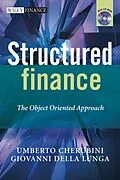Structured Finance: The Object Orientated Approach is aimed
at both the finance and IT professionals involved in the structured
finance business with the intention of sharing common concepts and
language within the industry. The financial community (structurers,
pricers and risk managers) view structured products as collections
of objects under the so-called replicating portfolio paradigm. The
IT community use object oriented programming (OOP) techniques to
improve the software updating and maintenance process. For them
structured products are collections of objects as well. Despite use
of the same object concept, it looks like communication
between these different professional functions has been
problematic. Recently, construction of standard data structures
known as FpML has begun to lay out a common definition of objects,
at least for plain vanilla derivatives, both between IT and
financial people and across different market players. Along this
line, this book builds upon the concept of object to provide
frontier treatment of structured finance issues relevant to both
communities engaged in building, pricing and hedging products and
people engaged in designing and up-dating the corresponding
software.
Structured Finance: The Object Orientated Approach will enable
you to:
* decompose a structured product in elementary constituent
financial objects and risk factors (replicating
portfolio)
* understand the basics of object oriented programming (OOP)
applied to the design of structured cash flows objects
* build your own objects and to understand FpML data
structures available for standard products
* gauge risk exposures of the objects in structured
products to: risk factors, their volatilities and the correlation
among them (which factor are you long/short? Are you long/short
volatility? Are you long/short correlation?)
* update your risk management system to accommodate structured
products with non linear exposures and to design objects to
represent, price and hedge, counterparty risk
Autorentext
UMBERTO CHERUBINI is Professor of Financial Mathematics at the University of Bologna. He is fellow of the Financial Econometrics Research Center (FERC), University of Warwick and Ente Einaudi, Bank of Italy. He teaches risk management programs for professionals at the Italian Banking Association, and does consulting work with Prometeia, an Italian firm specialized in research and consultancy in economics and finance. He has published in international journals in economics and finance and has co-written the book Copula Methods in Finance (published in 2004 by John Wiley).
GIOVANNI DELLA LUNGA is responsible for Market Risk Methodologies at Prometeia, an Italian firm specialized in research and consultancy in economics and finance. He teaches Finance and Computer Programming at University of Insubria (Varese, Italy) and has published in international journal in physics and chemistry.
Klappentext
Structured Finance: The Object Orientated Approach is aimed at both the finance and IT professionals involved in the structured finance business with the intention of sharing common concepts and language within the industry. The financial community (structurers, pricers and risk managers) view structured products as collections of objects under the so-called replicating portfolio paradigm. The IT community use object oriented programming (OOP) techniques to improve the software updating and maintenance process. For them structured products are collections of objects as well. Despite use of the same object concept, it looks like communication between these different professional functions has been problematic. Recently, construction of standard data structures known as FpML has begun to lay out a common definition of objects, at least for plain vanilla derivatives, both between IT and financial people and across different market players. Along this line, this book builds upon the concept of object to provide frontier treatment of structured finance issues relevant to both communities engaged in building, pricing and hedging products and people engaged in designing and up-dating the corresponding software.
Structured Finance: The Object Orientated Approach will enable you to:
- decompose a structured product in elementary constituent financial objects and risk factors (replicating portfolio)
- understand the basics of object oriented programming (OOP) applied to the design of structured cash flows objects
- build your own objects and to understand FpML data structures available for standard products
- gauge risk exposures of the objects in structured products to: risk factors, their volatilities and the correlation among them (which factor are you long/short? Are you long/short volatility? Are you long/short correlation?)
- update your risk management system to accommodate structured products with non linear exposures and to design objects to represent, price and hedge, counterparty risk
Inhalt
1 Structured Finance: A Primer.
1.1 Introduction.
1.2 Arbitrage-free valuation and replicating portfolios.
1.3 Replicating portfolios for derivatives.
1.3.1 Linear derivatives.
1.3.2 Nonlinear derivatives.
1.4 No-arbitrage and pricing.
1.4.1 Univariate claims.
1.4.2 Multivariate claims.
1.5 The structuring process.
1.5.1 The basic objects.
1.5.2 Risk factors, moments and dimensions.
1.5.3 Risk management.
1.6 A tale of two bonds.
1.6.1 Contingent coupons and repayment plans.
1.6.2 Exposure to the risky asset.
1.6.3 Exposure to volatility.
1.6.4 Hedging.
1.7 Structured finance and object-oriented programming.
References and further reading.
2 Object-Oriented Programming.
2.1 Introduction.
2.2 What is OOP (object-oriented programming)?
2.3 Analysis and design.
2.3.1 A simple example.
2.4 Modelling.
2.4.1 The unified modelling language (UML).
2.4.2 An object-oriented programming language: Java.
2.5 Main ideas about OOP.
2.5.1 Abstraction.
2.5.2 Classes.
2.5.3 Attributes and operations: the Encapsulation principle.
2.5.4 Responsibilities.
2.5.5 Inheritance.
2.5.6 Abstract classes.
2.5.7 Associations.
2.5.8 Message exchanging.
2.5.9 Collections.
2.5.10 Polymorphism.
References and further reading.
3 Volatility and Correlation.
3.1 Introduction.
3.2 Volatility and correlation: models and measures.
3.2.1 Implied information.
3.2.2 Parametric models.
3.2.3 Realized (cross)moments.
3.3 Implied probability.
3.4 Volatility measures.
3.4.1 Implied volatility.
3.4.2 Parametric volatility models.
3.4.3 Realized volatility.
3.5 Implied correlation.
3.5.1 Forex markets implied correlation.
3.5.2 Equity "average" implied correlation.
3.5.3 Credit implied correlation.
3.6 Historical correlation.
3.6.1 Multivariate GARCH.
3.6.2 Dynamic correlation model.
3.7 Copula functions.
3.7.1 Copula functions: the basics.
3.7.2 Copula functions: examples.
3.7.3 Copulas and survival copulas.
3.7.4 Copula dualities.
3.8 Conditional probabilities.
3.9 Non-parametric measures.
3.10 Tail dependence.
3.11 Correlation asymmetry.
3.11.1 Correlation asymmetry: finance.
3.11.2 Correlation asymmetry: econometrics.
<…